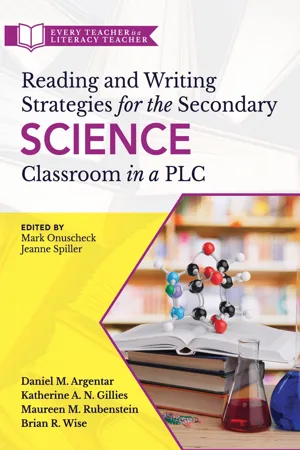
eBook - ePub
Reading and Writing Strategies for the Secondary Science Classroom in a PLC at Work®
(Literacy-based strategies, tools, and techniques for grades 6–12 science teachers)
This is a test
- 200 pages
- English
- ePUB (mobile friendly)
- Available on iOS & Android
eBook - ePub
Reading and Writing Strategies for the Secondary Science Classroom in a PLC at Work®
(Literacy-based strategies, tools, and techniques for grades 6–12 science teachers)
Book details
Table of contents
Citations
About This Book
Equip your students with the literacy support they need to think like scientists. Written by a team of experienced educators, this book provides practical literacy-based strategies designed for science teachers of grades 6-12. It can be read cover-to-cover or used as a quick reference for specific strategies. Learn how to connect science content with literacy skill development, differentiated instruction, designing meaningful assessments, effective feedback, and more.
Benefits:
- Understand the role that professional learning communities (PLCs) and science teachers play in literacy development and student-centered learning.
- Foster student engagement by utilizing adaptable strategies and literacy resources for developing pre-reading, during-reading, and post-reading skills.
- Learn why collaboration among different disciplines can enhance literacy instruction in secondary science education.
- Obtain tools and techniques for designing meaningful assessments that align literacy and science standards and improve student learning outcomes.
- Gain reflective knowledge to strengthen science and literacy instructional practices, encouraging learners to think like scientists.
Contents:
Preface
Introduction: Every Teacher Is a Literacy Teacher
Chapter 1: Collaboration, Learning, and Results
Chapter 2: Foundational Literacy Triage
Chapter 3: Prereading
Chapter 4: During Reading
Chapter 5: Postreading
Chapter 6: Writing
Chapter 7: Assessment
Frequently asked questions
At the moment all of our mobile-responsive ePub books are available to download via the app. Most of our PDFs are also available to download and we're working on making the final remaining ones downloadable now. Learn more here.
Both plans give you full access to the library and all of Perlego’s features. The only differences are the price and subscription period: With the annual plan you’ll save around 30% compared to 12 months on the monthly plan.
We are an online textbook subscription service, where you can get access to an entire online library for less than the price of a single book per month. With over 1 million books across 1000+ topics, we’ve got you covered! Learn more here.
Look out for the read-aloud symbol on your next book to see if you can listen to it. The read-aloud tool reads text aloud for you, highlighting the text as it is being read. You can pause it, speed it up and slow it down. Learn more here.
Yes, you can access Reading and Writing Strategies for the Secondary Science Classroom in a PLC at Work® by Daniel M. Argentar,Katherine A. N. Gillies,Maureen M. Rubenstein,Brian R. Wise in PDF and/or ePUB format, as well as other popular books in Bildung & Lehrmethoden für Lesekompetenz. We have over one million books available in our catalogue for you to explore.
Information
Table of contents
- Cover
- Title Page
- Copyright
- Acknowledgments
- Table of Contents
- About the Series Editors
- About the Authors
- Preface
- Introduction Every Teacher Is a Literacy Teacher
- Chapter 1 Collaboration, Learning, and Results
- Chapter 2 Foundational Literacy Triage
- Chapter 3 Prereading
- Chapter 4 During Reading
- Chapter 5 Postreading
- Chapter 6 Writing
- Chapter 7 Assessment
- Epilogue
- Appendix: Reproducibles
- References and Resources
- Index